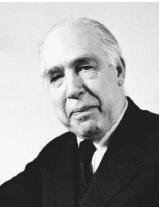Niels Bohr

DANISH PHYSICIST
1885–1962
Niels Bohr was one of the founders of modern atomic and nuclear physics. He was born into a family of intellectual and academic distinction. His father, Christian Bohr (1855–1911), was a professor of physiology; his brother, Harald Bohr (1887–1951), was a professor of mathematics; and his son, Aage Bohr (b. 1922), a professor of physics—all of them at the University of Copenhagen.
Niels Bohr studied at the University of Copenhagen and earned a master of science degree in 1909 and a doctorate degree in 1911 (at the age of twenty-six). He then went to England and worked with Joseph John Thomson at Cambridge University and with Ernest Rutherford at Victoria University in Manchester. In 1914 Bohr returned to the University of Copenhagen, where, at the age of twenty-nine, he became an assistant professor of physics (he became a full professor in 1916 and held that post until 1956). From 1920 onward he was the director of the university's Institute for Theoretical Physics (renamed the Niels Bohr Institute in 1965). The institute became a focal center for theoretical physics for a generation.
In 1913 Bohr (while still in England) published three papers on the quantum theory of atoms. He explained that atoms exist in "stationary" states, and that when an atom changes from one state to another, there has been an emission (or absorption) of electromagnetic radiation of frequency ν , determined by the energy difference between the two states.
Δ E = E 2 − E 1 = hν .
The constant h is Planck's constant. With this theory Bohr combined the atomic model of Rutherford with existing quantum theory, and he made it clear that classical physics was not sufficient to describe atoms or their behaviors. At first the Bohr theory was a theory that explained the behavior of hydrogen atoms. In the years to come he extended the theory to encompass all elements and to provide an explanation of the Periodic Table. The Bohr radius (52.9 × 10 −12 m) and the Bohr magneton (9.27 × 10 −24 J/T) are today used as units of measure. In 1922 Bohr received the Nobel Prize in physics.
Bohr deduced the correspondence principle: A quantum description of atoms must tend to the classical description for larger dimensions. He also deduced the complementarity principle: There are interactions between objects and the instruments used to observe them. Using the complementarity principle he concluded that there is always a limit to the ability of scientists to observe (and to know) atoms. With this concept he acquired an influence beyond the world of physics.
In the 1930s Bohr turned to nuclear physics. In 1936 he described an atomic nucleus as resembling a liquid drop existing in different states. In 1940 he and John Archibald Wheeler devised a theory of the fission of atoms, in it explaining the phenomenon of the accompanying release of atomic energy. In that same year Denmark was occupied by German military forces, and in 1943 Bohr fled to the United States via Sweden and England. In the United States he became a member of the Manhattan Project . After the war he returned to Denmark, where he continued to conduct research in atomic and nuclear physics.
In 1950 Bohr wrote an open letter to the United Nations warning of the horrors of nuclear war. In 1955 he organized the first Atoms for Peace Conference. Niels Bohr was one of the greatest scientists of the twentieth century.
SEE ALSO Rutherford, Ernest ; Thomson, Joseph John .
Ole Bostrup
Bibliography
Brock, William (1993). The Norton History of Chemistry. New York: Norton.
Greenberg, Arthur (2000). A Chemical History Tour. New York: Wiley.
Comment about this article, ask questions, or add new information about this topic: